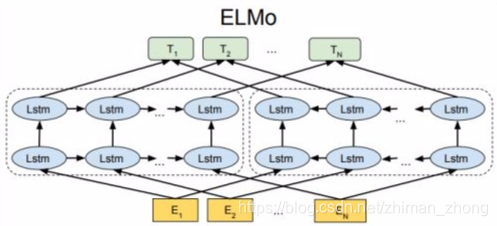詞向量——ELMo
ELMo( Embeddings from Language Models )詞向量模型,2018年3月在Deep contextualized word representations這篇論文中被提出,下面就幾個方面來介紹ELMo模型。
1.產生場景(為什麼產生)
word2vec、glove等詞向量模型有以下缺點:
(1)沒有捕捉到詞性等語法資訊,比如glove中

(2)每個詞對應一個詞向量,沒有解決一詞多義問題
2.特徵
ELMo是一種是基於特徵的語言模型,用預訓練好的語言模型,生成更好的特徵。
較高層的LSTM學習到了不同上下文情況下的詞彙多義性(在WSD task上表現很好),而較低層捕捉了到了語法方面資訊(可用作詞性標註任務中)。
與傳統的每個token被分配一個詞向量表示不同,ELMo中每一個詞語的表徵都是整個輸入句子的函式。
3.訓練
(1)語料庫:a corpus with approximately 30 million sentences (Chelba et al., 2014)
(2)訓練方法:雙向LSTM在大文字語料庫上用耦合語言模型(LM)目標訓練。



其中:是softmax-normalized權重,標量引數
允許任務模型來縮放整個ELMo向量。
4.評估
把ELMo預訓練的表示作為特徵加入到model中,表上baseline為不加,ELMo+baseline為新增ELMo為特徵,最右格給出了performance的絕對和相對提高。
文章第五部分還比較了adding position,正則化引數等的不同選擇給效能提升帶來的差異

評估用到的task主要是以下六種型別的NLP任務
(1)QA
dataset:The Stanford Question Answering Dataset (SQuAD),contains 100K+ crowd sourced questionanswer pairs where the answer is a span in a given Wikipedia paragraph
(2)Textual entailment(考慮到前提,假設是否屬實)
dataset:The Stanford Natural Language Inference (SNLI) corpus ,provides approximately 550K hypothesis/premise pairs.
(3)Semantic role labeling(模擬句子的謂詞 - 引數結構,通常被描述為回答“誰對誰做了什麼”)
dataset:the OntoNotes benchmark (Pradhan et al., 2013)
(4)Coreference resolution(clustering mentions in text that refer to the same underlying real world entities)
dataset:the OntoNotes coreference annotations from the CoNLL 2012 shared task (Pradhan et al., 2012)
(5)Named entity extraction
dataset:The CoNLL 2003 NER task (Sang and Meulder, 2003),consists of newswire from the Reuters RCV1 corpus tagged
with four different entity types (PER, LOC, ORG,MISC)
(6)Sentiment analysis
dataset:Stanford Sentiment Treebank (SST-5) involves selecting one of five labels (from very negative to very positive) to describe a sentence from a movie review.
另外,為了說明此模型很好的捕捉到了詞性和詞義,文章給出了兩個實驗,分別是WSD和POS tagging,用到的dataset分別是
SemCor 3.0和Wall Street Journal portion of the Penn Treebank (PTB)

